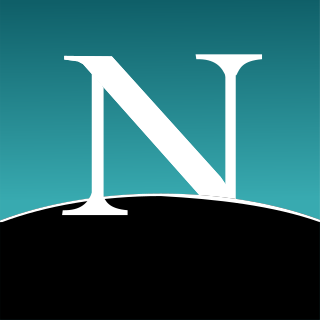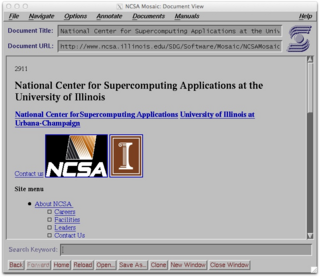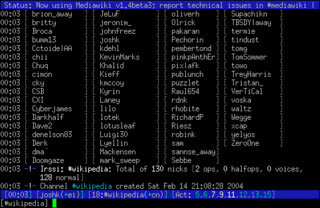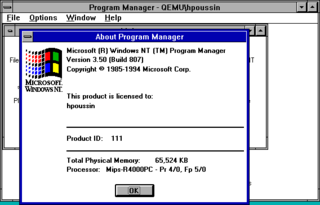
A bulletin board system or BBS is a computer server running software that allows users to connect to the system using a terminal program. Once logged in, the user can perform functions such as uploading and downloading software and data, reading news and bulletins, and exchanging messages with other users through public message boards and sometimes via direct chatting. In the early 1980s, message networks such as FidoNet were developed to provide services such as NetMail, which is similar to internet-based email.

Netscape Navigator was a proprietary web browser, and the original browser of the Netscape line, from versions 1 to 4.08, and 9.x. It was the flagship product of the Netscape Communications Corp and was the dominant web browser in terms of usage share in the 1990s, but by around 2003 its use had almost disappeared. This was partly because the Netscape Corporation did not sustain Netscape Navigator's technical innovation in the late 1990s.

A web browser is application software for accessing the World Wide Web. When a user requests a web page from a particular website, the web browser retrieves the necessary content from a web server and then displays the page on the user's device.

NCSA Mosaic was one of the first web browsers. It was instrumental in popularizing the World Wide Web and the general Internet by integrating multimedia such as text and graphics. It is a client for earlier internet protocols such as File Transfer Protocol, Network News Transfer Protocol, and Gopher. It was named for its support of multiple Internet protocols. Its intuitive interface, reliability, personal computer support, and simple installation all contributed to its popularity within the web. Mosaic is the first browser to display images inline with text instead of in a separate window. It is often described as the first graphical web browser, though it was preceded by WorldWideWeb, the lesser-known Erwise, and ViolaWWW.

Cello is an early, discontinued graphical web browser for Windows 3.1; it was developed by Thomas R. Bruce of the Legal Information Institute at Cornell Law School. It was released as shareware in 1993. While other browsers ran on various Unix machines, Cello was the first web browser for Microsoft Windows, using the winsock system to access the Internet. In addition to the basic Windows, Cello worked on Windows NT 3.5 and with small modifications on OS/2.

Dial-up Internet access is a form of Internet access that uses the facilities of the public switched telephone network (PSTN) to establish a connection to an Internet service provider (ISP) by dialing a telephone number on a conventional telephone line. Dial-up connections use modems to decode audio signals into data to send to a router or computer, and to encode signals from the latter two devices to send to another modem.
The Serial Line Internet Protocol (SLIP) is an encapsulation of the Internet Protocol designed to work over serial ports and router connections. It is documented in RFC 1055. On personal computers, SLIP has largely been replaced by the Point-to-Point Protocol (PPP), which is better engineered, has more features, and does not require its IP address configuration to be set before it is established. On microcontrollers, however, SLIP is still the preferred way of encapsulating IP packets, due to its very small overhead.
UUCP is an acronym of Unix-to-Unix Copy. The term generally refers to a suite of computer programs and protocols allowing remote execution of commands and transfer of files, email and netnews between computers.
An online service provider (OSP) can, for example, be an Internet service provider, an email provider, a news provider (press), an entertainment provider, a search engine, an e-commerce site, an online banking site, a health site, an official government site, social media, a wiki, or a Usenet newsgroup. In its original more limited definition, it referred only to a commercial computer communication service in which paid members could dial via a computer modem the service's private computer network and access various services and information resources such as bulletin board systems, downloadable files and programs, news articles, chat rooms, and electronic mail services. The term "online service" was also used in references to these dial-up services. The traditional dial-up online service differed from the modern Internet service provider in that they provided a large degree of content that was only accessible by those who subscribed to the online service, while ISP mostly serves to provide access to the Internet and generally provides little if any exclusive content of its own. In the U.S., the Online Copyright Infringement Liability Limitation Act (OCILLA) portion of the U.S. Digital Millennium Copyright Act has expanded the legal definition of online service in two different ways for different portions of the law. It states in section 512(k)(1):
(A) As used in subsection (a), the term "service provider" means an entity offering the transmission, routing, or providing of connections for digital online communications, between or among points specified by a user, of material of the user’s choosing, without modification to the content of the material as sent or received.
(B) As used in this section, other than subsection (a), the term "service provider" means a provider of online services or network access, or the operator of facilities therefore, and includes an entity described in subparagraph (A).

A shell account is a user account on a remote server, traditionally running under the Unix operating system, which gives access to a shell via a command-line interface protocol such as telnet, SSH, or over a modem using a terminal emulator.

Windows NT 3.5 is a major release of the Windows NT operating system developed by Microsoft and oriented towards businesses. It was released on September 21, 1994 and is the second release of Windows NT.
A remote access service (RAS) is any combination of hardware and software to enable the remote access tools or information that typically reside on a network of IT devices.
ZMODEM is a file transfer protocol developed by Chuck Forsberg in 1986, in a project funded by Telenet in order to improve file transfers on their X.25 network. In addition to dramatically improved performance compared to older protocols, ZMODEM offered restartable transfers, auto-start by the sender, an expanded 32-bit CRC, and control character quoting supporting 8-bit clean transfers, allowing it to be used on networks that would not pass control characters.

The Major BBS was bulletin board software developed between 1986 and 1999 by Galacticomm. In 1995 it was renamed Worldgroup Server and bundled with a user client interface program named Worldgroup Manager for Microsoft Windows. Originally DOS-based, two of the versions were also available as a Unix-based edition, and the last versions were also available for Windows NT-based servers.

The World Wide Web is a global information medium which users can access via computers connected to the Internet. The term is often mistakenly used as a synonym for the Internet itself, but the Web is a service that operates over the Internet, just as email and Usenet also do. The history of the Internet dates back significantly further than that of the World Wide Web.
The Internet Adapter (TIA) was software created by Cyberspace Development in 1993 to allow SLIP connections over a shell account. PPP was added in 1995, by which time the software was marketed and sold by Intermind of Seattle. Shell accounts normally only allow the use of command line or text-based software, but by logging into a shell account and starting the TIA daemon, a user could then run any TCP/IP-based application, including standard GUI software such as the then-popular Netscape Navigator on their computer. This was especially useful at the time because simple shell accounts were much less expensive than full SLIP/PPP accounts. TIA was ported to a large number of unix or unix-like systems.

Minnesota Internet Users Essential Tool (Minuet) is an integrated Internet package for DOS operating systems on IBM-compatible PCs.
A web browser is a software application for retrieving, presenting and traversing information resources on the World Wide Web. It further provides for the capture or input of information which may be returned to the presenting system, then stored or processed as necessary. The method of accessing a particular page or content is achieved by entering its address, known as a Uniform Resource Identifier or URI. This may be a web page, image, video, or other piece of content. Hyperlinks present in resources enable users easily to navigate their browsers to related resources. A web browser can also be defined as an application software or program designed to enable users to access, retrieve and view documents and other resources on the Internet.
InterCon Systems Corporation was founded in April 1988 by Kurt D. Baumann and Mikki Barry to produce software to connect Macintosh computers together. At the time, there was no real concept of the Internet and there was still a question of whether the TCP/IP protocols or OSI protocols would be adopted widely. Over the next 9 years, the company grew from three employees to over 100 and sold software in the US, Europe and Japan.

UdiWWW is an early, now discontinued freeware graphical HTML 3.2 web browser for 16-bit and 32-bit Microsoft Windows. It was written and developed by Bernd Richter in C/C++ from 1995 to 1996. Following the release of version 1.2 in April 1996, Richter ceased development, stating "let Microsoft with the ActiveX Development Kit do the rest."










